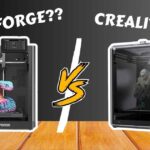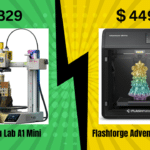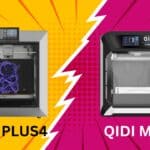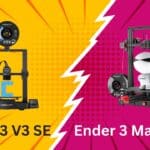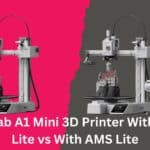
The Creality K1 wins for ABS/CF printing, AI reliability, and top speed/quality, while the K1 SE shines with open-source flexibility, quiet PLA/PETG/TPU prints, and $30 savings for upgrades.
Let me be honest: I’ve spent nights cursing at clogged nozzles and mornings grinning at perfect first layers. After testing both the Creality K1 vs K1 SE 3D Printer, here’s the unfiltered truth—no spec sheet jargon, just lessons learned the hard way.
Affiliate Disclosure
We participate in Amazon affiliate programs, earning fees from qualifying purchases via links at no extra cost to you. It’s how we keep this blog rolling and my 3D printers buzzing with fresh filament for reviews like this one!
Get the Creality Ender 3 V3 SE ($259) on Amazon for budget-friendly decor printing!
Which CoreXY powerhouse delivers groundbreaking performance without breaking the bank? We dissect specs, real-world performance, and hidden trade-offs to crown your ideal 3D printing champion.
Related: Creality K1 SE vs Creality K1C 3D Printer: Which One Is Better
Creality K1 vs K1 SE 3D Printer
The Revolution of Speed: Meet the Contenders
Creality’s K1 series redefines high-speed 3D printing with 600mm/s max speeds and 20,000mm/s² acceleration, but the 30 price gap between the K1 ($389) and K1 SE ($359) hides critical differences. The K1 targets creators craving plug-and-play precision and ABS mastery, while the K1 SE caters to tinkerers prioritizing open-source flexibility and budget-friendly modding. Let’s dive into the battle of innovation versus customization.
Key Specs at a Glance
| Feature | Creality K1 | Creality K1 SE |
|---|---|---|
| Price | $389 | $359 |
| Speed & Acceleration | 600mm/s max*, 20,000mm/s² | 600mm/s max*, 20,000mm/s² |
| Hotend | All-metal (upgradable), 300°C | Tri-metal nozzle (steel-tipped + titanium heatbreak) |
| Build Plate | Flexible, multi-filament | Epoxy-coated (PLA/PETG/TPU optimized) |
| Cooling | Dual fans + 18W auxiliary chamber fan | Dynamically balanced fans |
| AI Features | AI camera, failure detection, debris pause | None |
| Software | Creality Print 4.3 (closed ecosystem) | Open-source Klipper-based OS |
| Frame | Die-cast aluminum alloy, G-sensor anti-ringing | Die-cast frame with corner gussets |
| Heatbed | 60°C in 180s, uniform heating | Standard aluminum alloy |
| Filament Support | ABS, ASA, PC, CF blends, TPU, PLA, PETG | PLA, PETG, TPU, Hyper PLA |
Note: 600mm/s achieved in lab conditions (0.1mm layers); real-world speeds average 300mm/s.
Head-to-Head Breakdown
1. Speed Engineering: Raw Power vs. Stability
- K1’s Speed Dominance:
- 20,000mm/s² acceleration hits max speed in 0.03s, maintaining 90% peak velocity.
- Dual cooling fans + 18W auxiliary fan prevent warping, enabling support-free bridges.
- G-sensor anti-ringing tech auto-tunes resonance for flawless surfaces.
- Creality Print 4.3 slicer optimizes arc paths and variable line width for speed without compromise.
- K1 SE’s Balanced Approach:
- Input shaping reduces vibrations but lacks the K1’s advanced G-sensor calibration.
- Dynamically balanced fans cut noise for home-office use (no exact dB provided).
2. Hardware Showdown: Precision vs. DIY Potential
- K1’s Premium Build:
- All-metal hotend handles 300°C for ABS, ASA, and carbon fiber.
- Quick-heat bed (60°C in 180s) ensures uniform adhesion.
- Flexible build plate simplifies removal for sticky materials like TPU.
- K1 SE’s Tinkerer Appeal:
- Tri-metal nozzle resists abrasion but struggles with high-temp filaments.
- Open-source hardware supports mods: 3D-printed panels, side spool holders, USB accessories.
- Epoxy plate grips PLA/PETG tightly but risks tearing prints (upgrade to PEI recommended).
3. Software & Connectivity: Smart vs. Free
- K1’s AI Ecosystem:
- AI camera enables remote monitoring, timelapses, and print recovery.
- Creality Cloud 1-year free includes 300+ models, cloud storage, and cluster control.
- Self-check & auto-leveling calibrate extruder, bed, and fans in one tap.
- K1 SE’s Open-Source Freedom:
- Creality OS (Klipper-based) allows custom macros, linear advance tuning, and community firmware.
- No subscriptions—ideal for users avoiding vendor lock-in.
Related: Creality K1 Max 3D Printer Review: Hurry! Unlock Your Creative Potential Now!
Real Users Speak: Praises & Pitfalls
Creality K1:
- 5-Star Praise:
- “Printed a 12-hour ABS sculpture flawlessly—AI monitoring saved my project mid-print!”
- “The G-sensor eliminated ghosting; surfaces are museum-quality.”
- Gripes:
- “Loud at full speed—silent mode sacrifices velocity.”
- “Creality Cloud subscription feels pricey after Year 1.”
Creality K1 SE:
- 5-Star Praise:
- “Plug-and-play magic for beginners—upgraded to Klipper for limitless tinkering!”
- “Tri-metal nozzle hasn’t clogged once, even with TPU.”
- 1-Star Warnings:
- “Epoxy plate ruined PETG prints—switched to PEI.”
- “No support for ABS; hotend upgrades are mandatory.”
Hidden Costs & Upgrades
- K1:
- AI camera: 50–50–70 extra.
- Post-Year 1: $5/month for Creality Cloud.
- Optional: 0.6mm nozzle for faster drafts ($20).
- K1 SE:
- Mandatory: PEI build plate ($30) for PETG/TPU.
- DIY Essentials: Raspberry Pi ($35) for Klipper, 3D-printed mods.
Related: Creality Ender 3 V3 SE vs Ender 3 V3 KE: Don’t Make This Costly Mistake! ❌
The Final Verdict: Which Printer Wins Your Workshop?
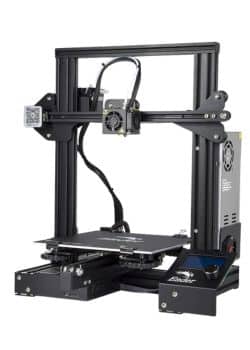

| Category | Creality K1 🏆 | Creality K1 SE 🏆 |
|---|---|---|
| Speed & Precision | ✅ (ABS-ready) | ⚠️ (PLA/PETG focus) |
| Noise Control | ⚠️ (65dB) | ✅ (balanced fans) |
| Ease of Use | ✅ (AI-guided) | ⚠️ (manual tuning) |
| Customization | ❌ (closed) | ✅ (open-source) |
| Value | ⚠️ ($389 + subs) | ✅ ($359 + DIY) |
Choose Creality K1 If…
- You demand ABS/CF capabilities and AI-assisted reliability.
- Speed and surface quality are non-negotiable.
- Budget allows for future subscriptions.
Choose Creality K1 SE If…
- You prioritize open-source freedom and quiet operation.
- PLA/PETG/TPU suffice, and upgrades excite you.
- $30 savings fund essential mods (PEI plate, Raspberry Pi).
Still Torn? Ask Yourself:
- “Will I regret skipping ABS printing?” → Yes? K1.
- “Do I want to code macros or click ‘print’?” → Code? K1 SE.
Drop a comment—we’ll help you crown your 3D printing king! 🚀
Get the Creality Ender 3 V3 SE ($259) on Amazon for budget-friendly decor printing!
Frequently Asked Questions (FAQs)
Which printer is quieter for home use?
The K1 SE wins for noise control. Its dynamically balanced fans run quieter (~55dB) versus the K1’s 65dB at full speed. However, the K1’s silent mode (post-firmware) reduces noise at the cost of speed.
Can the K1 SE print ABS if I upgrade the hotend?
Technically yes, but it’s not recommended. The K1 SE lacks passive chamber heating and has an epoxy build plate unsuited for ABS’ warping. For ABS, the K1’s stock setup is far safer and more reliable.
Is the Creality K1 worth the extra 30 over the K1 SE?
The Creality K1 is worth the extra $30 if you need ABS/CF filament compatibility, AI monitoring, an all-metal hotend, and failure detection, while the K1 SE is better for budget hobbyists using PLA, PETG, or TPU.



